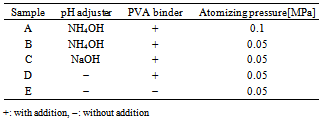-
Paper Information
- Next Paper
- Previous Paper
- Paper Submission
-
Journal Information
- About This Journal
- Editorial Board
- Current Issue
- Archive
- Author Guidelines
- Contact Us
International Journal of Materials and Chemistry
p-ISSN: 2166-5346 e-ISSN: 2166-5354
2013; 3(A): 16-20
doi:10.5923/s.ijmc.201303.03
Structure of Yttrium and Phosphorus-Containing Microspheres Prepared by Spray Dry Method
Masakazu Kawashita1, Kozue Nakamura1, Toshiki Miyazaki2, Hiroyasu Kanetaka3
1Graduate School of Biomedical Engineering, Tohoku University, Sendai, 980-8579, Japan
2Graduate School of Life Science and Systems Engineering, Kyushu Institute of Technology, Kitakyushu, 808-0196, Japan
3Liaison Center for Innovative Dentistry, Graduate School of Dentistry, Tohoku University, Sendai, 980-8575, Japan
Correspondence to: Masakazu Kawashita, Graduate School of Biomedical Engineering, Tohoku University, Sendai, 980-8579, Japan.
| Email: |  |
Copyright © 2012 Scientific & Academic Publishing. All Rights Reserved.
Microspheres containing yttrium (Y) and/or phosphorus (P) around 25 µm are useful for radioembolization therapy because they are activated to β-emitter by neutron bombardment and infused in blood vessels in the neighborhood of tumors to irradiateβ-rays to the tumors. In this study, we attempt to prepare Y and P-containing microspheres by spray drying method. Starting solution containing yttrium nitrate and phosphoric acid in equimolar ratio was spray dried under various conditions. Microspheres 5-30 µm in size are obtained when the starting solution with polyvinyl alcohol (PVA) binder was spray-dried at the atomizing pressure of 0.05 MPa. When the microspheres were heated at 1100ºC for 1 h, they precipitated Y-containing crystals such as yttrium phosphate (YPO4), yttrium oxide (Y2O3), yttrium polyphosphate (Y(PO3)3) and yttrium tetraphosphate (Y2P4O13) but most of them were ruptured. Without the PVA binder, small microspheres around 5 µm in size were formed but their shape remained even after the heat treatment. We found that the atomizing pressure of spray dryer remarkably affects the size of microspheres and PVA binder is essential to obtain microspheres around 25 µm, but addition of pH adjuster to starting solution is not essential. This study proposed the criterion of conditions to prepare Y and P-containing microspheres by spray drying method.
Keywords: Yttrium, Phosphorus, Microsphere, Spray Dry
Cite this paper: Masakazu Kawashita, Kozue Nakamura, Toshiki Miyazaki, Hiroyasu Kanetaka, Structure of Yttrium and Phosphorus-Containing Microspheres Prepared by Spray Dry Method, International Journal of Materials and Chemistry, Vol. 3 No. A, 2013, pp. 16-20. doi: 10.5923/s.ijmc.201303.03.
Article Outline
1. Introduction
- Cancer has been the top-ranking cause of death in many countries nowadays. Besides surgical method and chemotherapy, radiotherapy is also widely used for treatment of cancer. Conventional radiotherapy is performed using an external radiant source. Only when radiation is emitted at a high dose, it can achieve effective treatment for cancer deeply seated inside the body. The high irradiation results in damage of surrounding normal tissue. Recently, an internal embolic radiotherapy is attracting our interest because it make possible the local irradiation to deep-seated cancer with little irradiation damage to normal tissue.Since yttrium-89 (89Y) and phosphorus-31 (31P) can be activated to form β-emitters: 90Y and 32P, respectively, by neutron bombardment, Y and/or P-containing microspheres around 25 μm in size are suggested to be useful for embolic radiotherapy of cancer. When these microspheres are implanted into the target tumor tissue through blood vessels by a catheter, they are entrapped in the capillary bed of the tumors and irradiate tumor tissue locally by emitting β-rays. In fact, yttrium alumino silicate glass microspheres (TheraSphere®)[1] and Y-containing resin microspheres (SIR-Spheres®)[2] have been used clinically to treat metastatic liver carcinoma and unresectable hepatocellular carcinoma in various countries including the United States, Canada, China, Australia, New Zealand, Singapore, and European countries. Recently, yttrium oxide (Y2O3) microspheres prepared by high-frequency induction thermal plasma method[3] or yttrium phosphate (YPO4) microspheres prepared by sol-gel method have been proposed[4]. However, the high-frequency induction thermal plasma method requires the large and expensive equipment and is not suitable for producing microspheres containing elements that is easily evaporated at high temperature of plasma flame. The sol-gel techniques sometimes have problems such as low productivity and poor reproducibility.
2. Materials and Methods
2.1. Preparation of Samples
- Yttrium nitrate (Y(NO3)3, Wako Pure Chemicals, Tokyo, Japan) solution was mixed with phosphoric acid solution (H3PO4, Wako Pure Chemicals, Tokyo, Japan) in a molar ratio of 1:1. The concentration of Y(NO3)3 and H3PO4 was 0.1 M. The final pH value of the solution was adjusted to 6-7 by the addition of aqueous ammonia (NH4OH; Wako Pure Chemicals, Tokyo, Japan)[9] or sodium hydroxide (NaOH; Wako Pure Chemicals, Tokyo, Japan)[4]. After the solution was well stirred at 50ºC for 3 h, white precipitation were obtained. Finally, polyvinyl alcohol (PVA; Wako Pure Chemicals, Tokyo, Japan) was dissolved into the liquid at a concentration of 2 mass% as a binder at 70ºC.The above starting liquid was fed into the spray dryer (DL410, Yamato Scientific, Tokyo, Japan) and sprayed. The parameters of the spray dryer were set as the follows: inlet temperature at 240ºC, outlet temperature art 90ºC, hot airflow at 0.8 m3/min, feed rate of liquid volume at 25 mL/min and the atomizing pressure of spray at 0.05 or 0.1 MPa. Finally, the obtained samples were placed in an alumina boat, heated to 1100ºC at a rate of 5°C/min in an electric furnace, and kept at the given temperature for 1 h. Table 1 gave preparation conditions of samples in this study.
|
2.2. Structural Analysis of Samples
- The shapes of the microspheres were observed using a scanning electron microscope (SEM; VE-8800, Keyence, Osaka, Japan). The precipitated phase was examined with a powder X-ray diffractometer (XRD; RINT-2200VL, Rigaku, Tokyo, Japan) using the following settings: X-ray source, Ni-filtered CuKα radiation; X-ray power, 40 kV, 40 mA; scanning rate, 2θ = 2 º/min; and sampling angle, 0.02º. The elements contained in Sample E after heat treatment were analyzed by energy dispersive X-ray (EDX) spectrometer (XL30FEG, FEI, Oregon, USA).
3. Results
3.1. Structure of Samples before Heat Treatment
- Figure 1 shows SEM photographs of Samples A-E before heat treatment (as-spray dried). When the atomizing pressure of 0.1 MPa was employed and pH adjuster of NH4OH and binder of PVA were added to starting solution (Sample A), microspheres with sizes ranging from 5 to 15 µm were obtained, but their yield was extremely low because the considerable amounts of samples attached on the chamber of the spray dryer. Also, some particles had irregular shape and formed aggregates. When the atomizing pressure was decreased to 0.05 MPa with addition of PVA binder (Samples B-D), microspheres with rough surface having sizes of 5-30 µm were obtained in high yield. Without PVA binder, small microspheres around 5 µm were obtained (Sample E).
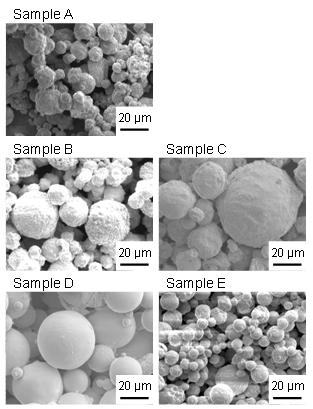 | Figure 1. SEM photographs of Samples A-E before heat treatment |
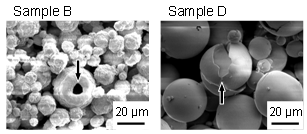 | Figure 2. SEM photographs of Samples B and D before heat treatment in another observed area |
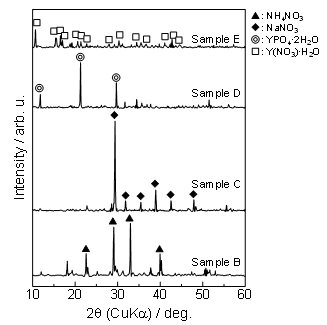 | Figure 3. XRD patterns of Samples B-E before heat treatment |
3.2. Structure of Samples after Heat Treatment
- Figure 4 shows SEM photographs of Samples B-E after heat treatment. In Samples B-D, most of microspheres were ruptured by the heat treatment and hollow structure indicated by an arrow was observed. Broken pieces of thin wall of hollow microspheres were also observed in Sample D. In Sample E, some microspheres were shrunk but the shape of the microspheres remained even after the heat treatment.
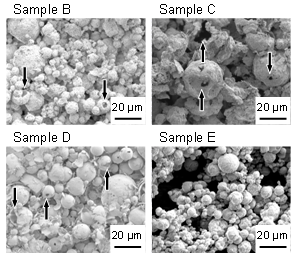 | Figure 4. SEM photographs of Samples B-E after heat treatment |
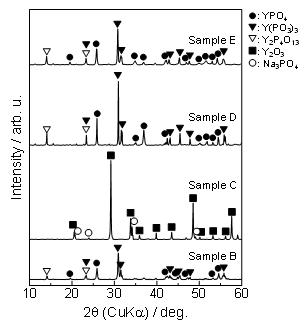 | Figure 5. XRD patterns of Samples B-E after heat treatment |
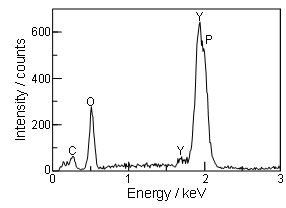 | Figure 6. EDX spectrum of Sample E after heat treatment |
4. Discussion
4.1. Effect of Atomizing Pressure
- The present results clearly indicate that the atomizing pressure affects the size of sample. Namely, the atomizing pressure of 0.1 (Sample A) gave microspheres 5-15 in size in low yield, and that of 0.05 (Sample B) gave particles 5-30 µm in size in high yield (see Fig. 1). With increasing atomizing pressure, the nozzle of the spray dryer produces smaller droplets resulting in small microspheres. The small microspheres are light and easily attaches on the wall of chamber, which results in low yield. Similar phenomena were observed for another concentration (1 wt%) of PVA binder (data were not shown). We can conclude that the particle size can be controlled by changing atomizing pressure, which was also observed for formation of magnesium ferrite microspheres[11].
4.2. Effect of pH Adjuster
- Samples B and C precipitated NH4NO3 and NaNO3 before heat treatment, respectively (see Fig. 2). This might be because pH adjusters of NH4OH and NaOH reacted with NO3- ions in the starting solution.After the heat treatment, Sample B precipitated YPO4, Y(PO3)3 and Y2P4O13 (see Fig. 3). This implies that NH4NO3 was thermally decomposed to produce gases according to the following reaction[12].NH4NO3 → N2O (g) + 2H2O (g)This gas formation might cause the rupture of microspheres during the heat treatment.In Sample C, Y2O3 and Na3PO4 were precipitated after the heat treatment. Poorly-soluble Na3PO4 might be precipitated by reaction between Na+ ions and PO43- ions during heat treatment. As a result, Y2O3 rather than yttrium phosphate compounds tended to be formed by the heat treatment[13]. According to the results of Samples B and C, addition of pH adjuster sometimes causes the precipitation of crystalline phases containing unwanted elements such as N and Na other than Y, P and O.Samples D and E were prepared without addition of pH adjuster. Before heat treatment, Samples D and E precipitated YPO4·2H2O and Y(NO3)3·H2O, respectively, but both of them precipitated YPO4, Y(PO3)3 and Y2P4O13 after the heat treatment. It is reported that addition of pH adjuster induces precipitation of precursor in the starting solution[4,8]. But, in this study, there was no correlation between amount of precipitated precursor in staring solution and yield of resultant microspheres. In addition, Sample D prepared without pH adjuster had smoother surface than Sample C prepared with pH adjuster (see Fig. 1). These results suggest that pH adjustment is not essential to obtain microspheres although we must note that strong acid or basic starting solution might give damage to component of spray dryer.
4.3. Effect of PVA Binder
- As described in section 4.2, Samples D and E precipitated YPO4·2H2O and Y(NO3)3·H2O, respectively, suggesting that addition of PVA binder make effects on crystalline phase of samples before heat treatment. The detailed mechanism is still unclear, but high temperature at around 70ºC in dissolving PVA might enhance the chemical reaction of starting solution.Without the addition of PVA binder (Sample E), small microspheres around 5 µm were formed. Also, the Sample E was mainly composed of O, Y and P (see Fig. 6). The small microspheres were not appreciable for radioembolization, but it is noted that the shape of microspheres was retained even after the heat treatment. According to results about Samples D and E, we can conclude that thermal decomposition of PVA is responsible for the rupture of microspheres during the heat treatment. In the process of spray drying, the droplets transform into solid and/or hollow microspheres by evaporating solvent from the starting solution. When the starting solution contains binder such as PVA, the evaporation of the solvent is suppressed to some degree, resulting in formation of larger microspheres[14]. Here, it is noted that microspheres were not formed even before heat treatment when the PVA concentration was decreased to 1 wt% (data were not shown). Therefore, the optimum PVA concentration is estimated to be between 1 and 2 wt%.It is expected that the rupture of microspheres owing to heat treatment can be suppressed by further modification of heat treatment condition. That is, lower heat treatment temperature and/or lower increasing rate of temperature would be effective for retention of shape of microspheres even after heat treatment.From a view of clinical application in embolic radiotherapy of cancer, the spherical-shaped microspheres are more desirable than the irregular-shaped microspheres because they might inhibit the physical damage to artery during the infusion. However, even the irregular-shaped particles might be clinically appreciable in radiotherapy of bone metastases when they are successfully dispersed in bone cements[15, 16].
5. Summary
- Microspheres 5-30 µm in size are obtained when the starting solution with PVA binder was spray-dried at the atomizing pressure of 0.05 MPa. When the microspheres were heated at 1100ºC for 1 h, they precipitated Y-containing crystals such as YPO4, Y2O3, Y(PO3)3 and Y2P4O13 but most of them were ruptured owing to thermal decomposition of PVA. Without the PVA binder, small microspheres around 5 µm in size were formed but their shape remained even after the heat treatment. In conclusion, the atomizing pressure of spray dryer remarkably affects the size of microspheres and PVA binder is essential to obtain microspheres around 25 µm, but addition of pH adjuster to starting solution is not essential.
ACKNOWLEDGEMENTS
- This work was partially supported by Grant-in-Aid for Scientific Research (B) (No. 22300163), the Ministry of Education, Culture, Sports, Science and Technology (MEXT), Japan.
 Abstract
Abstract Reference
Reference Full-Text PDF
Full-Text PDF Full-text HTML
Full-text HTML